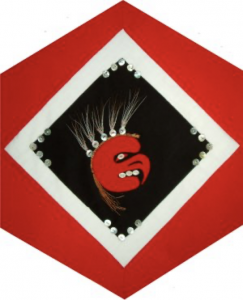Nuxalk

The Block
Lillian Siwallace chose the Thunderbird as the central feature of the Nuxalk block, to represent her people. Using traditional materials, she created this ferocious mask depicting the face of the thunder god, as designed by Foster Walkus. Thunderbird masks are used in the most powerful and respected dance of the Nuxalk, the Dance of Thunder. Lillian anchored tufts of moose hair to a cedar-braid scalp on red wool felt, using abalone shell buttons, to form the hairline of this “thunderbird”. The mask exhibits beautifully contrasted by a background of black broadcloth.
Cultural Profile
The Nuxalk were previously known by an anglicized version of their name, Bella Coola, which came from the Heiltsuk language. Their language is a dialect of Coast Salish. They are located in the Bella Coola Valley along the central coast of British Columbia, traditional lands which they have never ceded, sold, surrendered, or lost through acts of war. The ocean and rivers provided the Nuxalk with oolichan and salmon, while the mountains and valleys offered wildlife, forests, berries and medicinal plants.
The Nuxalk traded with the peoples of the interior plateau. The trails, to and fro, became known as the Nuxalk-Carrier Grease Trail. It was along these trails that native guides led explorer Alexander Mackenzie in 1793. In his journals, Mackenzie recalls the warm welcome he received from the Nuxalk. Not long after Mackenzie’s visit, these same trails became vital to the ever-growing North American fur trade. It was this contact with white fur traders that brought about the horrifying decimation of the Nuxalk people, when smallpox wiped out a third of the population in the mid-1800s.
During the 1930s the Nuxalk suffered a series of devastating floods that forced some to move to the south side of the Bella Coola River. They managed to save the Emmanuel United Church built by the community in 1900. It was floated across the swollen river on a barge, to the music of a brass band. A picture of this memorable event hangs now in the church sanctuary.
The Nuxalk, who currently number over 1200 persons, hold strong to their cultural traditions developed over thousands of years. Feasting and potlatching are again a vibrant part of Nuxalk culture following a long government ban on such celebrations, lasting from 1884 to 1951. The potlatch is an opportunity to pass on family names. Their complex system of social and political organization has not been lost, only adapted slightly to the changing times. Today, the Nuxalk operate under the Indian Act Band Council system, but retain an organization of hereditary chiefs who draw their authority to govern from the Smayusta–the creation stories that outline their traditions, language and culture.
Sponsor: Inge U. and Dieter Scholz
